In der Presse und fotonahen Medien wird aktuell über ein Comeback der analogen Fotografie berichtet. Warum? Nostalgie mag eine Rolle spielen, Romantik, Emotionen, die Erinnerung an die 50-er bis 80-er Jahre oder auch die Haptik und die Mechanik analoger Geräte. Diese erwecken nun bei Foto Fans erneut Begeisterung nach jahrelanger Abkehr und der Hinwendung zu digitalen Kameras, die wir nun seit über 25 Jahren erleben.
Die Überfrachtung moderner digitaler Kameras mit Eigenschaften, die kaum jemand benötigt, mit Menues die z.T. tief verschachtelt sind und spontanes Fotografieren verzögern oder völlig unmöglich machen, überfordern viele. Vielleicht ist das einer der Gründe, warum Fotografen der Sucherkamera den Rücken kehren und sich stattdessen dem Smartphone zuwenden. Die runde weiße Smartphone Taste macht dies alles – sofort. Die Bedienungsanleitung beispielsweise einer Canon EOS R5 füllt mehr als 900 Seiten. Wenn wundert es da noch?
Diese Überlegungen haben mich zu dem nachstehenden Experiment motiviert. Die verwendeten Brennweiten, Blendenwerte und Verschlusszeiten aller Geräte waren, soweit technisch möglich, gleich. Die Distanz zwischen Kamera und Motiv war für alle gleich.
Die verwendeten Aufnahmegeräte:
- EXAKTA VAREX IIa, analoge Kleinbild Spiegelreflexkamera der Ihagee Kamerawerke Dresden mit Objektiv Jena Tessar, 1:2,8, f/50mm
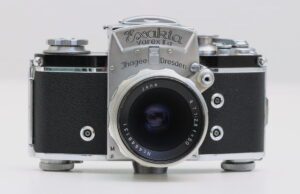
- Kodak Retina IIc made in Germany, analoge Sucherkamera mit Objektiv Schneider-Kreuznach, 1:2,8, f/50mm
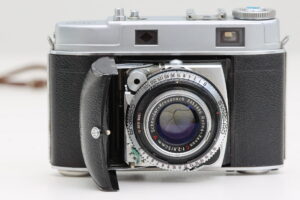
- Fuji X-H1, digitale APS-C Systemkamera, 24MP Auflösung mit Objektiv Fujinon Super EBC, 1:1,4, f/35 mm (Cropfaktor 1,5 entspricht analog 50 mm
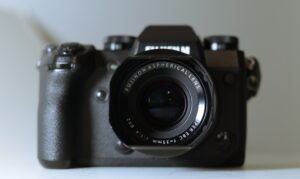
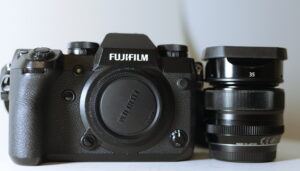
- CCanon EOS R5, 45 MP, Vollformat mit Objektiv Canon EF 1:1,8, f/50mm STM
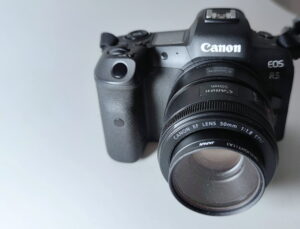
- Smartphone Xiaomi Mi 10T Pro, 8GB RAM, Qualcomm Snapdragon 865 Prozessor, 256 GB Speicherplatz, Triple-Kamera (108 + 13 + 5 MB).

Die Belichtungen mit den digitalen Kameras erfolgten in Farbe.
Die Kernfrage lautet also: wie schlägt sich eine gute analoge Kamera der 60-er Jahre im Vergleich zur digitalen Kamera unserer Tage?
Die folgenden Bilder zeigen interessante Ergebnisse.
**********************************************************************************************************
The press and photo-related media currently are reporting on a comeback of the analog photography. Why? Nostalgia may play a role, romanticism, emotions, memories of the 50s to the 80s, or the feel and mechanics of analog equipment.
Can we explain and understand this new trend among photo fans after years of turning away from analog cameras and turning to digital cameras, which we now have been experiencing for over 25 years? Yes, I think so. The overload of modern digital cameras with features that hardly anyone needs, with menues that are sometimes deeply convoluted, that delay or do not allow spontaneous photography in some cases at all, overwhelm many. Perhaps this is one of the reasons why photographers are turning their backs on viewfinder cameras and turning to smartphones instead. Using the white button does it all. The user manual of a Canon EOS R5, for example, fills more than 900 pages. So ??
These considerations motivated me to conduct the experiment below. The focal lengths, aperture values and shutter speeds used for all devices were the same, as far as technically possible. The distance between camera and subject was the same for all.
These considerations motivated me to run the experiment below. The focal lengths, aperture values and shutter speeds used for all devices were the same, as far as technically possible. The distance between camera and subject was the same for all.
The cameras used:
EXAKTA VAREX IIa, analog 35mm SLR camera made by Ihagee Kamerawerke Dresden with Jena Tessar lens, f/2.8, f/50mm.
Kodak Retina IIc made in Germany, analog viewfinder camera with Schneider-Kreuznach lens, 1:2.8, f/50mm
Fuji X-H1, digital APS-C system camera, 24MP resolution with lens Fujinon Super EBC, f/1.4, f/35 mm (cropfactor 1.5 corresponds to analog 50 mm)
Canon EOS R5, 45MP, full frame with lens Canon EF f/1.8, f/50mm STM
Smartphone Xiaomi Mi 10T Pro, 8GB RAM, Qualcomm Snapdragon 865 processor, 256 GB storage, triple camera (108 + 13 + 5 MB).
The exposures with the digital cameras were taken in color.
So, the key question is: How does a good analog camera of the 60s perform compared to the digital one of our days?
The following images are showing interesting results.
Beginnen wir mit der Exakta Varex IIa:
Let´s get started with the Exakta Varex IIa:

Bei den analogen Kameras wurde auch ein Motiv unter Berücksichtigung der jeweiligen Naheinstellgrenze hinzugefügt : 50 cm Exakta Varex IIa, 80 cm Kodak Retina IIc.
For the analog cameras, a subject was also added considering the respective closest focusing distance : 50 cm Exakta Varex IIa, 80 cm Kodak Retina IIc.
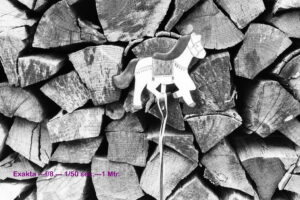
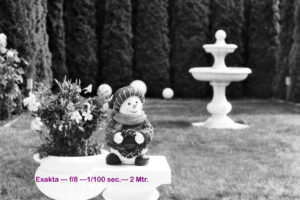
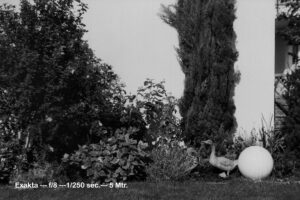

Nun zur Kodak Retina IIc
Then Kodak Retina IIc

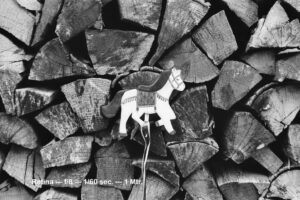
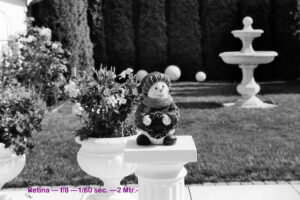
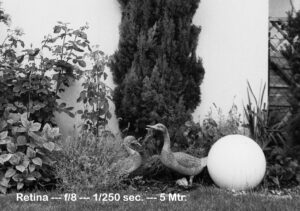
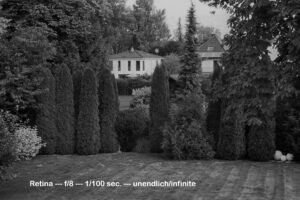
Nun zur Fuji X-H1
Then Fuji X-H1
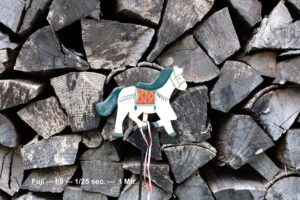



Nun zur Canon EOS R5
Then Canon EOS R5


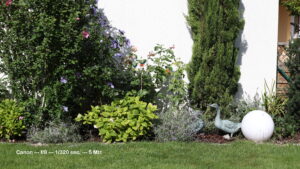
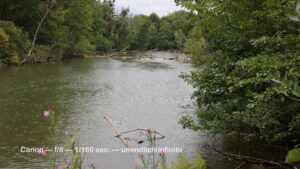
Nun zu Xiaomi M10T Pro
Finally Xiaomi Mi10T Pro
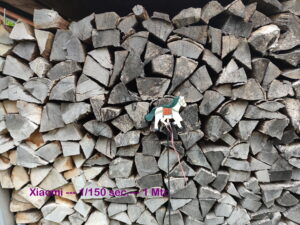

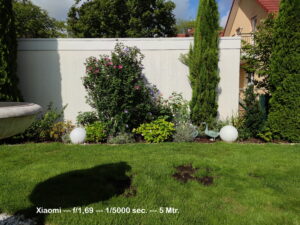
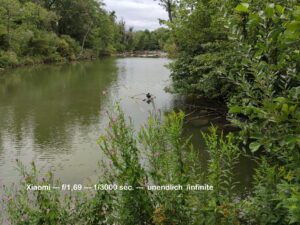
Welche Ergebnisse sehen wir? Bei den beiden analogen Kleinbild Kameras handelt es sich um relativ hochwertige Produkte der 60/70-er Jahre. Ausstattung, Qualität und optische Leistung waren anerkannt. Die Abbildungsleistung beider Kameras ist nach wie vor OK mit m.E. leichten Vorteilen der Kodak Retina IIc – mehr aber auch nicht.
Im direkten Vergleich der Bildergebnisse wird deutlich, was 60 Jahre Weiterentwicklung in beiden Sektoren erbrachten, der Kameratechnik und der Objektive.
Jedoch nicht nur dies. Das unmittelbar nach der Belichtung verfügbare digitale Bild, das vielfältig variiert und im Falle von Fehlern sofort wiederholt werden kann, die sofortige Nutzbarkeit in Social Media oder zur eigenen Erbauung, fast unendliche Speicherkapazität auf SD-Karte und Co., Post Processing am PC ohne Labor bzw. Dunkelkammer mittels unzähliger Softwareprodukte und last but not least der Zeit- und Kostenfaktor (Film + Labor) sind m.E. unschlagbare Vorteile der Gegenwart im Vergleich zu damals. Vielleicht bleiben dadurch Nostalgie, Emotion auf der Strecke. Vielleicht auch nicht. Das ist eine 100% persönliche Angelegenheit.
***********************************************************************************************************
What results do we see? The two analog 35 mm cameras have been relatively high-quality products in the 60s/70s. Features, quality and optical performance were well recognized. The imaging performance of both cameras is still OK with, in my opinion, slight advantages of the Kodak Retina IIc – but nothing more.
The direct comparison of the image results is clearly demonstrating what progress 60 years of further development in both sectors have brought, the camera technology and the lenses.
But not only that. The digital image available immediately to the photographer, which can be varied in many ways and immediately repeated in the event of errors, the usability in social media or for one’s own enjoyment in no time, almost infinite storage capacity on SD cards and the like, post processing on the PC without a lab or darkroom, countless software products, and last but not least the time and cost factor (film and lab) are, in my opinion, unbeatable advantages of the present compared to back then. Maybe nostalgia and emotion fall by the wayside. Maybe not. This is a 100% personal matter.
